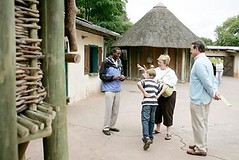Cultural studies and political correctness vs. authentic interpretation

KEN LAMBERT / THE SEATTLE TIMES. Kenneth Sokoine Ntalamia, left, is part of Woodland Park Zoo's Maasai Journey program. Ntalamia speaks with Carolyn and Al Wight, who are visiting from Georgia, and their grandson Griffin Donaldson, 7, of Seattle.
Interesting story in the Seattle Times about Maasi interpreters being employed as part of a particular exhibit area at the Seattle Zoo. See "A misguided use of zoo guides?"
From the article:
But some professors and students at the University of Washington say the zoo's use of Maasai is insensitive and hearkens back to the days when zoos across the nation used people of color as accessories to exhibits.
"I find it a bit disturbing that you're going to get to know a culture in a zoo setting," said Catherine Claiborne, who's helping organize a public forum tonight to discuss the issue. Claiborne, a master's candidate in public affairs and international studies at the UW, said the Maasai Journey could lead people to "associate African people with animals, and African Americans with animalism."
The Maasai Journey, which runs through September, includes a re-created African village adjacent to the Savannah animal exhibit. The Maasai lead tours of the village and exhibits, tell stories about their culture, and lecture about conservation.
A paper the zoo prepared in response to concerns about the program says displaying people is indeed a "repulsive concept." But that's not what the zoo is doing, officials say. "In fact, these are employees of our education department, in Western clothing, who teach visitors about conservation," the zoo's written statement says.
Hamisi, who obtained a bachelor's degree at The Evergreen State College and travels between the United States and Kenya, said he's upset people are using the Maasai's history as "a vehicle to raise race issues." He said he knows the unfortunate history of American zoos that exploited people of color. But this program is different, he said. "We're not out there holding monkeys," he said.
One thing that surprises me about this is the failure to be allowed to rethink how to teach culture. Aren't zoos cultural resources? Wouldn't it make sense for zoos to reorganize their presentations around the cultural and physical landscapes of the places from which the animals come from?
Although I do understand the concern about putting people of other ethnicities on display and the fear of strengthening still prevalent steroetypes and racism.

At the Historic Jamestown Museum, they have constructed a replica of the first fort there, with crops and reenactors. There were some goats and chickens moving around as well.
But is the zoo exhibit that much different from Colonial Williamsburg, the people who come from other places to be participants in the Smithsonial Folklife Festival, or Old Sturbridge Village in Massachusetts?

John Canavan used an ax to work on building a new home. (Boston Globe Staff Photo / David L Ryan)
Still, I would argue the field of cultural interpretation has moved quite a bit forward since the way that the natives were portrayed in Tarzan movies and television in the 1950s.
And, if your interpretation reflects the latest scholarship, such as global political economy and Marxist interpretations even, you can use history to explain and address even the ugly history of the past.
For example, last week I talked about the history of the area where Brookland DC is, to a group of 4th, 5th, and 6th graders. This area was the frontier of Maryland, hard to work, and the business was agriculture. It was not plantation style agriculture, but slavery was part of the history, and I was upfront about it. Except for one Asian and one caucasian, all the audience was African-American.
You can't learn about history and culture if you don't ever talk about it. Why shouldn't the role of zoos be reinterpreted and modernized to reflect advances in the presentation of cultural heritage and sustainable and eco- tourism?

Historical interpreter for Colonial Williamsburg, Robert Watson, center, works a field as a group of visitors watches on the Great Hopes Plantation in Williamsburg, Va. Thursday, May 19, 2005. Colonial Williamsburg recently opened the plantation in its attempts to freshen history. Great Hopes Plantation replicates an 18th century, middle-income plantation complete with black field slaves and a tiny slave dwelling. (AP Photo/Steve Helber)
Labels: cultural heritage/tourism, cultural planning, museums, zoos



0 Comments:
Post a Comment
<< Home